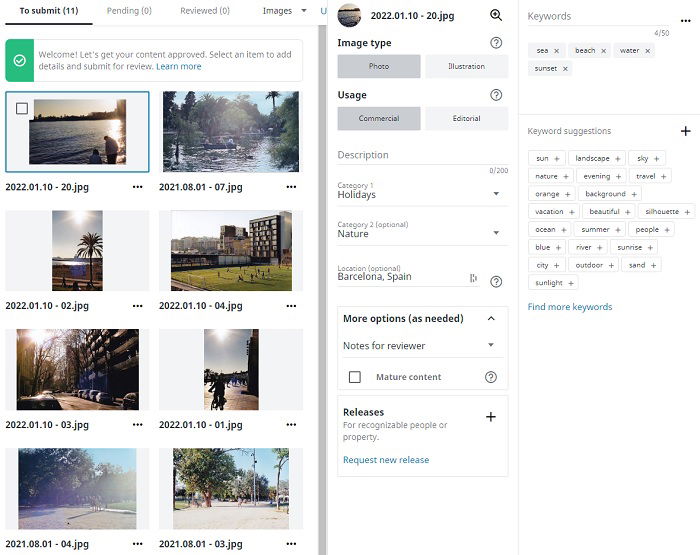Getty Images has carved out a significant place in the world of visual media. If you're a photographer looking to showcase and sell your work, you’ve likely come across Getty Images. Founded in 1995, they provide images, video, and music for digital marketing and advertising, among other uses. Through their platform, you can reach a vast audience of potential buyers, including brands, agencies, and individuals. With millions of contributors and billions of media assets available, it’s an exciting space for creatives.
What makes Getty stand out? Well, it’s not just the breadth of its collections. Getty Images has built a reputation for quality and professionalism, ensuring that every image meets strict licensing and editorial standards. This means that as a contributor, you have the opportunity to align your work with a respected brand and gain credibility in the marketplace. But before you jump into submitting your photos, it's essential to get familiar with how the platform operates and what the Contributor Program entails.
Understanding the Contributor Program

The Contributor Program at Getty Images is designed to empower photographers and videographers to monetize their creative work. By becoming a part of this program, you can license your images to a global audience. But what does this really mean for you as a contributor?
Here's a breakdown:
- Eligibility: Almost anyone with a decent camera and a unique perspective can become a contributor. However, having high-quality images is crucial.
- Registration: Start by signing up on the Getty Images website. You will provide some basic information about yourself and your work.
- Submission Process: After registration, you can upload your images. Getty has specific guidelines regarding the file format, resolution, and content that you must follow.
- Approval Rate: Not all submissions get approved. It’s important to understand the standards Getty sets; they are looking for high-quality, relevant content.
- Royalty Structure: As a contributor, you earn money whenever your images or videos are downloaded. Getty pays contributors based on the licensing model chosen by the buyer. The more popular your work, the more you can earn!
This program gives you a unique chance to have your work seen by countless individuals and organizations worldwide, turning your passion for photography into a sustainable income stream. So, if you're ready to dive into the world of stock photography, understanding the Contributor Program is your first step!
Also Read This: LinkedIn Resume Builder Guide
3. Preparing Your Photos for Submission

When it comes to submitting your photos to Getty, preparation is everything. Taking stunning photos is just the first step; how you present them for submission matters significantly. Here’s a quick guide to ensure your images are ready for the spotlight.
*1. File Type: Getty prefers JPEG format for uploads. Ensure your photos are saved in high-quality JPEG to maintain their quality while allowing for manageable file sizes.
2. File Size and Resolution: Aim for high-resolution images, ideally at least 300 DPI (dots per inch). This ensures your photos are sharp and clear, even when printed. Most contributors submit images that are around 12 megapixels or higher.
3. Editing: Post-processing is crucial. Use software like Adobe Lightroom or Photoshop to enhance your images. Adjust the exposure, contrast, saturation, and cropping. Just remember, keep it natural—excessive filters can turn off potential buyers.
4. Metadata: Metadata acts as the key to your photo’s reach. Include clear descriptions, keywords, and model or property releases when applicable. This will help buyers find your images easily. Tools like Adobe Bridge can assist with this.
5. Quality Control: Before hitting that submit button, conduct a thorough check. Look for any blemishes, overexposed highlights, or underexposed shadows that need fixing. A clean, polished photo is more likely to catch the eye of potential buyers.
Also Read This: how to flatten image photoshop
4. Tips for Creating High-Quality Images

Crafting high-quality images is an art and a science. Whether you’re a seasoned photographer or just starting, there are key techniques you can employ to elevate your photography game. Here are some tips to help you on your journey towards stunning visual storytelling.
1. Lighting: Natural light is your best friend. Shoot during the golden hour—just after sunrise or before sunset—to capture that warm, soft glow. If you're shooting indoors, position your subjects near windows for beautiful, diffused light.
2. Composition: Master the rules of composition, such as the Rule of Thirds. Imagine dividing your frame into nine equal segments. Try placing points of interest along those lines or at their intersections to create a balanced and engaging photograph.
3. Focus: Ensure your subjects are sharp and in focus. Use a shallow depth of field to blur distracting backgrounds, making your subject pop. On the other hand, if you want everything in frame to be sharp, use a higher f-stop.
4. Experiment: Don’t shy away from trying new angles and perspectives. Get low to the ground, climb up high, or even try shooting through objects to add depth and intrigue to your photos.
5. Storytelling: Every image should tell a story. Think about what emotion or message you want to convey and frame your shot accordingly. Ask yourself, "What do I want the viewer to feel?" This will guide your creative process and make your photos more impactful.
Also Read This: How to Edit Your Project Name on Behance Tips for Updating Your Portfolio
5. Crafting Effective Keywords and Descriptions

When it comes to selling your photos on Getty, the importance of effective keywords and descriptions cannot be overstated. These elements are essentially what make your images discoverable. If your keywords are off or your description doesn't clearly define the content of your photo, it might just get lost in the sea of submissions. So, how do you ensure that your photo stands out?
- Be Specific: Choose keywords that precisely describe the subject matter. Instead of vague terms like "nature", use more concrete descriptors such as "mountain landscape" or "autumn leaves".
- Use Multiple Relevant Keywords: Don’t just stick to a handful of keywords. Getty allows you to use a range of keywords, so include synonyms, related terms, and geographical references when applicable. This opens up various search avenues for potential buyers.
- Focus on Context: Think about the context of your images. If your photo could be useful in a particular scenario—like a business meeting or an outdoor adventure—mention that in your description.
- Write Clear Descriptions: Your description should complement your keywords. Clearly outline what’s happening in the photo, the emotions it evokes, and any relevant background information. This helps buyers connect more with your work.
- Keep Style in Mind: Consider the tone of Getty’s buyers. Are they looking for something more commercial or artistic? Tailor your approach depending on your target audience.
Remember, keywords and descriptions are your first line of communication with potential buyers. Invest the time to get them right, and you’ll significantly improve your chances of making a sale.
Also Read This: How to Print 4 Images on One Page: Easy Steps for Efficient Printing
6. Navigating the Submission Process
Now that you have your beautiful images ready and optimized with keywords and descriptions, it’s time to tackle the submission process. Don’t worry, it’s not as daunting as it might seem. Here’s a step-by-step approach to make the process as smooth as possible:
- Create an Account: Start by signing up as a contributor on Getty Images. You’ll need to provide some basic information and accept the terms and conditions. Make sure to read them thoroughly!
- Upload Your Photos: Once your account is set up, you can begin uploading your images. Keep in mind, high-resolution photos are crucial—aim for at least 300 dpi for the best quality.
- Add Your Keywords and Descriptions: This is where your previous work pays off. For each uploaded image, add in the keywords and detailed descriptions you crafted earlier. This step drives the discoverability of your uploads.
- Review and Submit: Before clicking that submit button, double-check everything. Ensure your images look great, keywords are relevant, and descriptions are clear. Any inconsistencies might delay the approval process.
- Follow Up: After submission, be patient but proactive. Check the status of your submissions regularly. Sometimes, going the extra mile to respond to inquiries or required corrections can speed things up!
Submission might feel like a hurdle, but with a little preparation, you can breeze through this essential step. Remember, it’s all about presenting your work in the best light possible to attract buyers!
Also Read This: Explanation of Adobe Stock’s Symbol
7. Maximizing Your Earnings as a Contributor
When it comes to selling your photos on Getty, your earnings potential can really skyrocket if you know how to leverage your contributions effectively. Here are some tips to help you maximize your earnings:
- Upload High-Quality Images: Always ensure your photos are of professional quality. Use the best camera equipment and pay attention to lighting, composition, and post-processing. The clearer and more engaging your images, the higher the chances they’ll sell.
- Understand Your Niche: Focus on a specific subject or theme that resonates with buyers. Whether it's nature, travel, food, or lifestyle photography, by becoming a specialist, you can attract more targeted interest.
- Keywording and Metadata: Take the time to accurately tag and describe your images. The right keywords can significantly boost your visibility in search results and ultimately lead to more sales.
- Stay Current with Trends: Keep an eye on what types of images are trending. Adapting your portfolio to include timely and relevant content can make your work more appealing to potential buyers.
- Engage with Buyers: Build a reputation as a reliable contributor by communicating professionally and promptly with any inquiries or requests about your work.
By following these strategies, you can create a more lucrative experience as a Getty contributor. It’s all about positioning yourself effectively and being proactive about your contributions!
Also Read This: How to Create a Professional Portfolio on Behance for Beginners
8. Promoting Your Portfolio on Social Media
In today’s digital age, social media is an invaluable tool for promoting your photography portfolio on Getty. Here’s how you can maximize your reach and attract buyers:
- Use Visual Platforms: Focus on platforms like Instagram and Pinterest, which are founded on sharing images. Post your best work regularly and engage with users who have a passion for photography.
- More Than Just Photos: Share behind-the-scenes shots, editing tips, and even short videos showcasing your photography process. This helps to create a connection with your audience.
- Hashtag Wisely: Incorporate relevant hashtags to increase discoverability. Research trending hashtags within the photography community to get in front of new spectators.
- Collaborate with Other Creatives: Partner with fellow photographers or artists to cross-promote each other’s work. This can lead to exposure to new audiences and increased credibility.
- Engage With Your Followers: Take time to respond to comments and messages. Building a community around your work fosters loyalty and encourages shares, which can lead to more sales.
Promoting your Getty portfolio on social media isn't just about shouting into the void; it's about creating meaningful connections that can turn casual viewers into potential buyers!
Also Read This: Opening Adobe Stock Image Previews in Photoshop
9. Staying Updated with Market Trends
In the fast-paced world of photography and online selling, being aware of market trends can make or break your success as a Getty contributor. You might be wondering, how do I stay relevant? Well, let’s break it down!
First and foremost, follow industry news. Websites, magazines, and blogs dedicated to photography often discuss emerging trends and top-selling styles. Consider subscribing to newsletters from sites like PetaPixel or Fstoppers to receive updates directly in your inbox.
Next, keep an eye on Getty’s own offerings. Regularly check the “trending” sections on their site to see what types of images are gaining traction. Note the themes, colors, and styles that are popular right now. This will give you an idea of what buyers are currently looking for.
Social media is another fantastic tool. Platforms like Instagram and Pinterest can reveal the latest aesthetic preferences and ideas in photography. Don't hesitate to engage with fellow photographers; it can offer insights you wouldn’t find elsewhere.
Here’s a quick checklist to help you stay updated:
- Follow photography blogs and forums
- Review trending sections on stock photo sites
- Engage with photographers on social media
- Participate in photography webinars and workshops
- Network at photography events and expos
By consistently educating yourself on market trends, you’ll gear your work towards what’s in demand, enhancing your chances of selling your photos successfully on Getty.
10. Conclusion and Final Thoughts
Congratulations! You’re now equipped with knowledge on how to sell your photos on Getty as a contributor. It’s a thrilling journey that combines passion, creativity, and a bit of business savvy. Let’s recap what we’ve covered and offer some final encouragement.
First, remember that quality counts. Invest in good equipment and take the time to perfect your craft. Your photos need to stand out among thousands of others, so attention to detail is crucial.
Next, don’t shy away from diversifying your portfolio. By capturing a variety of subjects and styles, you’ll appeal to a broader audience. From stunning landscapes to emotional portraits, think of every shot as an opportunity to tell a story.
Also, always keep your ear to the ground for market trends*. Staying updated will help you anticipate what buyers want and give you a competitive edge. Utilize the resources and community available to you – learning from others can be incredibly valuable!
Lastly, don’t get discouraged at the beginning. It might take time to see significant sales, but persistence and consistent refinement of your skills will pay off. So, go out there, take those pictures, and remember: every click of the shutter brings you closer to success!
 admin
admin








